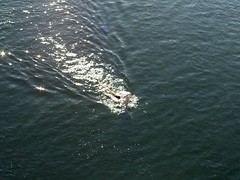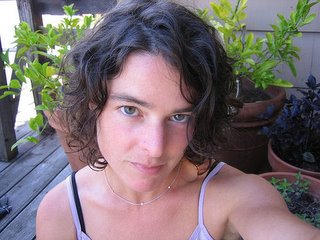how-to manuals
After Axel arrived, my dear friend Ayelet sent us some books with the note:
They've got these fabulous block images in bright colors, showing the myriad daddies and mommies out there: with mismatched socks and crazy hair, surfing and dancing, cooking and working, painting pictures and flying airplanes. He loves them. (And, despite the glaring absence of bicycles, the books are pretty accurate representations of the Mychal-Amy conglomerate.)
It took me a while, but eventually I got us some parenting books. The first to enter the house was about sleep. I know people who've read all of the sleep books and w ho could have given me advice. But we put it off until we'd lost all patience completely, and one day I simply got in the car, drove to the nearest bookstore that wasn't a conglomerate and scanned the shelves. Well, shelf. I was tempted by a book whose author had Ph.D. following her name and reluctant to give a second glance to a book with a corny title. By an author who calls herself the "sleep lady." Sleep lady? But the god-awful writing of the first and the practicality of the second decided the matter. Ayelet had described a sleep-training program that had a parent in a chair in the doorway of the child's room reading--an adult book, not a child's book. That sounded pretty good to me. So once at the bookstore, I scanned books looking for "chair in the doorway." It didn't take too long. The book could have been a pamphlet, as the method can be summarized in three sentences (okay, maybe ten). And it worked. So that book is on our shelf.
ho could have given me advice. But we put it off until we'd lost all patience completely, and one day I simply got in the car, drove to the nearest bookstore that wasn't a conglomerate and scanned the shelves. Well, shelf. I was tempted by a book whose author had Ph.D. following her name and reluctant to give a second glance to a book with a corny title. By an author who calls herself the "sleep lady." Sleep lady? But the god-awful writing of the first and the practicality of the second decided the matter. Ayelet had described a sleep-training program that had a parent in a chair in the doorway of the child's room reading--an adult book, not a child's book. That sounded pretty good to me. So once at the bookstore, I scanned books looking for "chair in the doorway." It didn't take too long. The book could have been a pamphlet, as the method can be summarized in three sentences (okay, maybe ten). And it worked. So that book is on our shelf.
I bought our second parenting book that same night. I wasn't looking for one and wasn't motivated by the same desperation as our need to sleep through the night. But the easy prose and refreshing honesty sold me. So the best parenting book ever joined the sleep book on our shelf (As soon as I had read it cover to cover, in a mad dash. It's that good.).
The third book on our shelf appeared ten days after Axel had a fever of 105 degrees--under his armpit. I kind of thought it was too high--even called my sister for moral support, and, after she'd looked at her parenting books about medical stuff, called the doctor. Who is an aging hippy, and told us, "well, it could go as high as 106." Ok, but what do I do then? Especially if it's after 5 pm? So, after several calls and conversations with advice nurses and a late-night trip to the emergency room where they tortured Axel (blood draw and a catheter) to find out exactly nothing, I hopped on amazon and bought Your Child's Health. This book is still on the shelf, but having read it cover to cover in two days (impatiently, fruitlessly looking for the information I needed and cursing the book's ridiculous organization), it's shelf-life is nigh to expire. Still looking for that encyclopediac book about "My Child's Health" which will let me cross-reference symptoms with ailments. One-handed and in the dark, of course.
The last book to make the shelf just arrived for my birthday. This one will stay--despite the fact that I'd already borrowed it from the library and read three-quarters. It's one of those book that is permanently on hold (translation: no renewals). I haven't finished the library copy and it was due yesterday, and I'm wracking up fines as I write.
It's written by a neuroscientist, although the truly awful passages are not the scientific explanations, but the anecdotal examples. Otherwise, it is fascinating reading, describing in minute detail the neurological development from conception onward and how that impacts motor and cognitive development. Despite the author's biological background, she presents a strong argument for the importance of environment in shaping an individual's experience and intelligence. Too paraphrase her, "environment is everything."
"You may not need books to understand your baby, but here are some books to help explain you two to him."
They've got these fabulous block images in bright colors, showing the myriad daddies and mommies out there: with mismatched socks and crazy hair, surfing and dancing, cooking and working, painting pictures and flying airplanes. He loves them. (And, despite the glaring absence of bicycles, the books are pretty accurate representations of the Mychal-Amy conglomerate.)
It took me a while, but eventually I got us some parenting books. The first to enter the house was about sleep. I know people who've read all of the sleep books and w
 ho could have given me advice. But we put it off until we'd lost all patience completely, and one day I simply got in the car, drove to the nearest bookstore that wasn't a conglomerate and scanned the shelves. Well, shelf. I was tempted by a book whose author had Ph.D. following her name and reluctant to give a second glance to a book with a corny title. By an author who calls herself the "sleep lady." Sleep lady? But the god-awful writing of the first and the practicality of the second decided the matter. Ayelet had described a sleep-training program that had a parent in a chair in the doorway of the child's room reading--an adult book, not a child's book. That sounded pretty good to me. So once at the bookstore, I scanned books looking for "chair in the doorway." It didn't take too long. The book could have been a pamphlet, as the method can be summarized in three sentences (okay, maybe ten). And it worked. So that book is on our shelf.
ho could have given me advice. But we put it off until we'd lost all patience completely, and one day I simply got in the car, drove to the nearest bookstore that wasn't a conglomerate and scanned the shelves. Well, shelf. I was tempted by a book whose author had Ph.D. following her name and reluctant to give a second glance to a book with a corny title. By an author who calls herself the "sleep lady." Sleep lady? But the god-awful writing of the first and the practicality of the second decided the matter. Ayelet had described a sleep-training program that had a parent in a chair in the doorway of the child's room reading--an adult book, not a child's book. That sounded pretty good to me. So once at the bookstore, I scanned books looking for "chair in the doorway." It didn't take too long. The book could have been a pamphlet, as the method can be summarized in three sentences (okay, maybe ten). And it worked. So that book is on our shelf.I bought our second parenting book that same night. I wasn't looking for one and wasn't motivated by the same desperation as our need to sleep through the night. But the easy prose and refreshing honesty sold me. So the best parenting book ever joined the sleep book on our shelf (As soon as I had read it cover to cover, in a mad dash. It's that good.).
The third book on our shelf appeared ten days after Axel had a fever of 105 degrees--under his armpit. I kind of thought it was too high--even called my sister for moral support, and, after she'd looked at her parenting books about medical stuff, called the doctor. Who is an aging hippy, and told us, "well, it could go as high as 106." Ok, but what do I do then? Especially if it's after 5 pm? So, after several calls and conversations with advice nurses and a late-night trip to the emergency room where they tortured Axel (blood draw and a catheter) to find out exactly nothing, I hopped on amazon and bought Your Child's Health. This book is still on the shelf, but having read it cover to cover in two days (impatiently, fruitlessly looking for the information I needed and cursing the book's ridiculous organization), it's shelf-life is nigh to expire. Still looking for that encyclopediac book about "My Child's Health" which will let me cross-reference symptoms with ailments. One-handed and in the dark, of course.
The last book to make the shelf just arrived for my birthday. This one will stay--despite the fact that I'd already borrowed it from the library and read three-quarters. It's one of those book that is permanently on hold (translation: no renewals). I haven't finished the library copy and it was due yesterday, and I'm wracking up fines as I write.
It's written by a neuroscientist, although the truly awful passages are not the scientific explanations, but the anecdotal examples. Otherwise, it is fascinating reading, describing in minute detail the neurological development from conception onward and how that impacts motor and cognitive development. Despite the author's biological background, she presents a strong argument for the importance of environment in shaping an individual's experience and intelligence. Too paraphrase her, "environment is everything."




0 Comments:
Post a Comment
<< Home